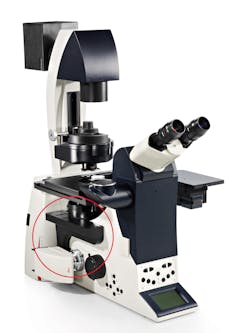Leica Microsystems inverted microscope stand for widefield and confocal microscopy

The Leica DMI6000 B inverted microscope stand from Leica Microsystems (Wetzlar, Germany) features Adaptive Focus Control (AFC) for widefield (including TIRF) and confocal applications to dynamically regulate focus position. AFC can also be operated in stand-alone mode without a PC connection or additional external control devices.
-----
PRESS RELEASE
New Leica DMI6000 B with Adaptive Focus Control (AFC)
Published: 30.09.10
Explore Life in All Dimensions
Wetzlar, Germany. Imaging dynamic processes in living cells is challenging, even for the most precise and reliable microscopy systems. The Leica DMI6000 B inverted microscope stand is at the heart of our widefield or confocal systems for live cell imaging, offering unsurpassed stability inherent to its design. But even the most robust microscope will be susceptible to sudden changes in temperature, for instance when a climate chamber is opened during an experiment to apply a drug to the specimen. This can result in out-of focus images during time-lapse recordings. Leica Microsystems has now developed a Leica DMI6000 B with Adaptive Focus Control (AFC) for researchers who demand consistent multidimensional imaging.
The fully automated AFC is based on the reflection of a light beam at a suitable surface (e.g. petri dish) to keep the distance between the objective and the specimen constant. Available for both widefield (including TIRF) and confocal applications, AFC dynamically regulates the focus position, whenever or wherever the experiment requires it. For more flexibility, AFC can also be operated in stand-alone mode and requires neither a PC connection nor additional external control devices.
The underlying technique works for all selected contrasting methods and does not involve the acquisition of images. This ensures that cells remain viable for longer, delivering reliable results even over extended periods of time. The intelligent automation of the system provides the ultimate in ease of use, automatically optimizing all settings for each objective. With the option to effectively combine AFC with a high-speed digital auto focus, cells which change their morphology and shape during the course of the experiment are now easy to follow, while minimizing exposure to light.
The new Leica Adaptive Focus Control is available for Leica DMI6000 B, Leica AM TIRF MC, Leica TCS SP5 II, Leica TCS SP5 II DS, and Leica TCS SP5 MP.